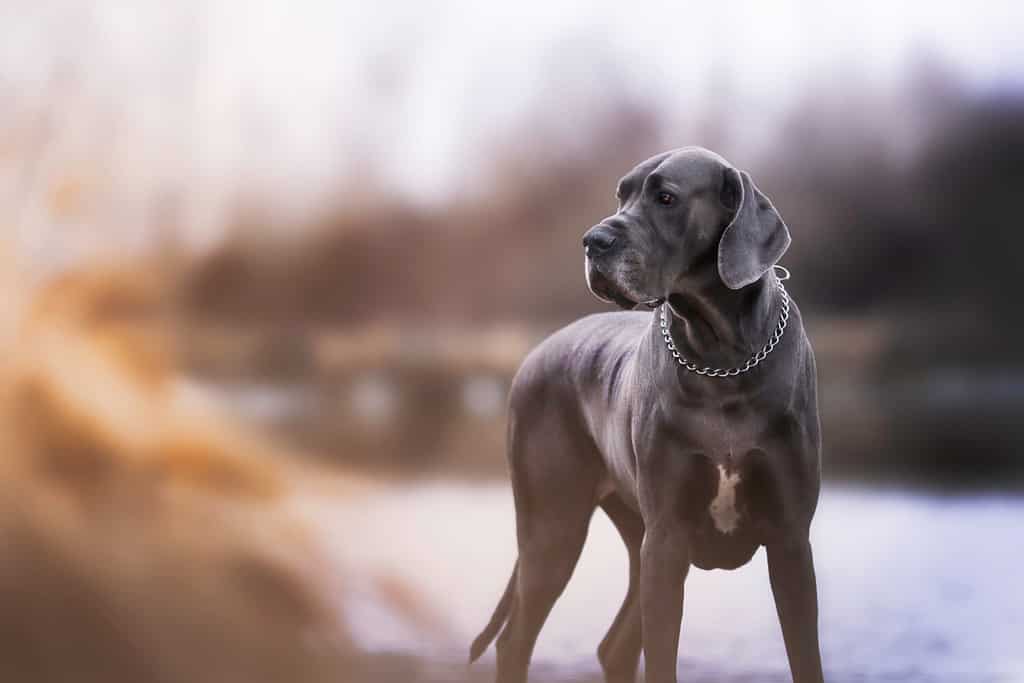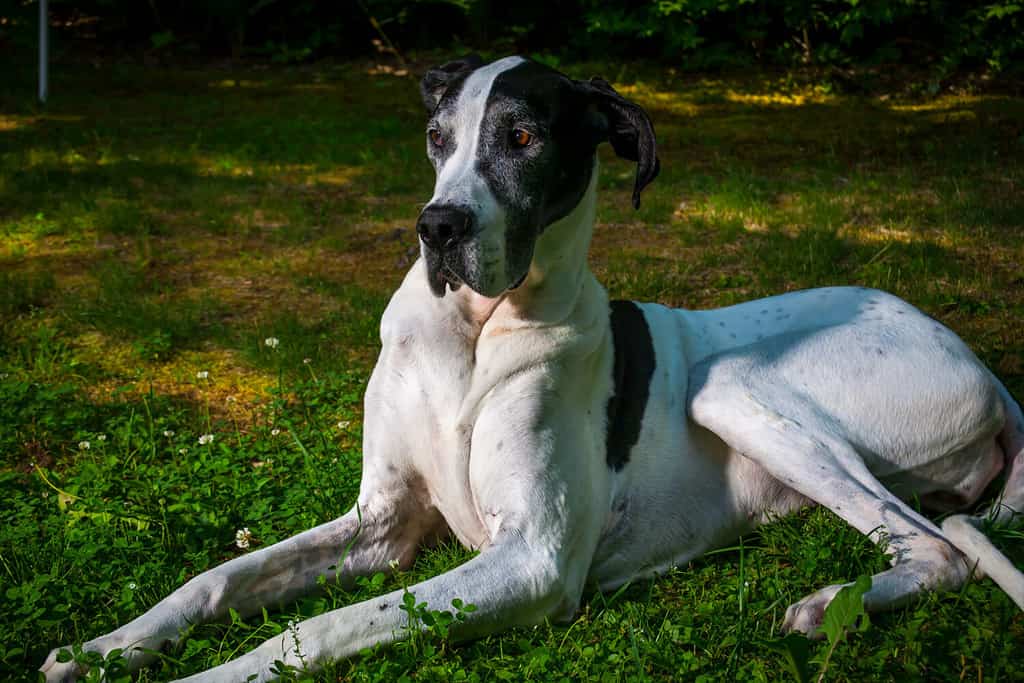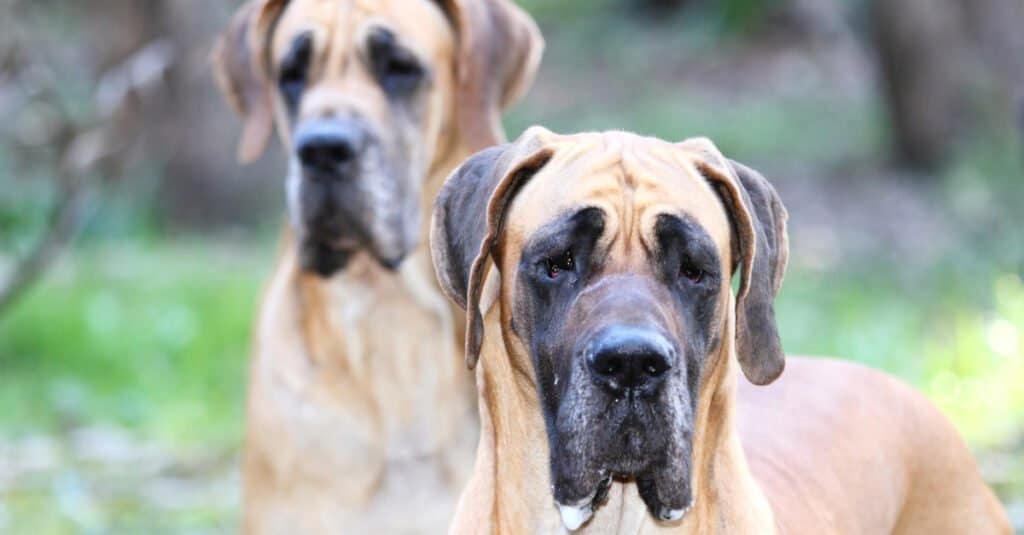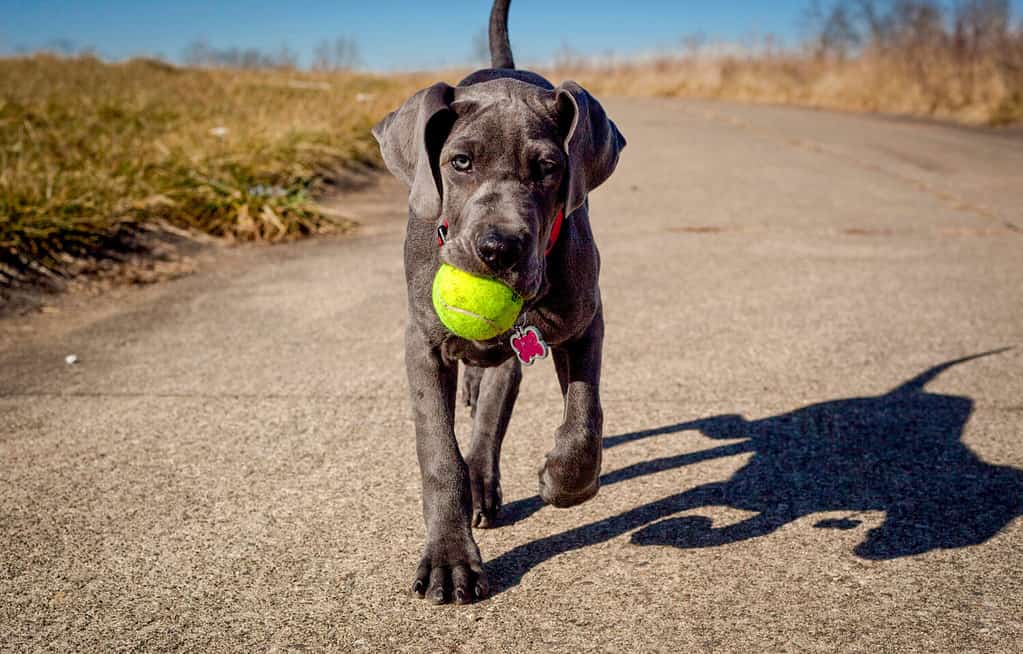Great Danes are popular because of their easy-going nature and affectionate personality. The Great Dane is a giant breed that originated in Germany. They can weigh as much as the average man and easily take up the entire length of your couch. Commonly called gentle giants, Great Danes are trainable and friendly to strangers.
A descendant of the mastiff and the Irish wolfhound, The Great Dane coined the nickname, “The Apollo of the Dog,” because of its patience, gentle temperament, and regal body. They are gentle with kids and thrive in a family lifestyle. People enjoy them as canine companions due to their size, personality, and lack of need for excessive exercise. But what are the differences between a male vs. female Great Dane?
| Male Great Dane | Female Great Dane | |
|---|---|---|
| Size | 30-32 in. at shoulders, 140-175 lbs. | 28-30 in. at shoulders, 110-140 lbs. |
| Physical Traits | Short, smooth coat in a variety of colors, broader in features | Short, smooth coat in a variety of colors, narrower in features |
| Reproduction | Sexual maturity at 18-24 mo. | Fertile at first heat cycle at 6-24 mo., sexual maturity at 2 years. Fertile only during heat cycles every 12-18 mo. |
| Health | Bloat, prostate cancer, hip dysplasia, Osteosarcoma | Mammary cancer, uterine tumors, bloat, hip dysplasia, Osteosarcoma |
| Temperament | Patient, affectionate, friendly, silly or goofy | Patient, affectionate, friendly, quicker to mature, more independent |
| Training | Easy to train, intelligent, short attention span, responds well to positive reinforcement, higher boldness & aggression | Easy to train, intelligent, longer attention span and better focus, responds well to positive reinforcement |
Key Differences Between a Male and Female Great Dane

The Great Dane coined the nickname, “The Apollo of the Dog, because of its temperament and iconic physical features.
©verky01/Shutterstock.com
The key differences between male vs. female Great Danes are their height, physical traits, reproductive role, temperament, and responses to training.
At first glance, it may be hard to tell the difference between a male vs. female Great Dane, but there are many small differences in their physical features to help tell them apart. Reproductively, the females develop and mature faster than males. Males produce sperm, and females are responsible for carrying, birthing, and taking care of puppies. While the Great Dane is an affectionate, patient dog, their temperament does differ slightly in gender. This can cause different responses to training and socialization as they develop. Read on to understand these key differences in detail.
Male vs. Female Great Dane: Size
The Great Dane is an intelligent giant breed with a short, smooth coat. Males will reach 30-32 inches tall at the shoulders, and females will reach 28-30 inches tall. When fully grown, males weigh 140-175 pounds and females weigh 110-140 pounds. Both genders reach their maximum height around 18 months, and they are fully grown between 18-24 months of age.
Male vs. Female Great Dane: Physical Traits
Size is the first physical trait people notice about the Great Dane. Regardless of gender, this gentle giant is recognizable by its sheer size coupled with its easy-going nature. Their coat comes in seven different colors and patterns for both males and females. Because of its short, smooth coat, grooming responsibilities are minimal.
Males are typically taller and heavier than females, and they have broader features. Females tend to look leaner than males due to their height-to-weight ratio. Both genders naturally have longer, floppy ears and a long, thin tail. Many choose to dock their tails and crop their ears during puppyhood. Great Danes often experience “happy tail,” meaning their excitement can cause an overactive tail and eventually lead to injury.
Male vs. Female Great Dane: Reproduction

Contrary to popular belief, Great Danes originated in Germany, not Denmark. They are descendants of the Irish wolfhound and the mastiff.
©Arthur Villator/Shutterstock.com
Reproductive systems are a major difference between male vs. female Great Danes. Overall, male Great Danes have testes and produce sperm, while female Great Danes have ovaries and can become pregnant, give birth, and care for a litter of puppies. Male Great Danes reach sexual maturity between 12 and 15 months and can reproduce throughout their lifetime. Females experience their first heat cycle between six and 24 months, and it repeats every 12-18 months. During the heat cycle, males can impregnate the fertile females.
During a heat cycle, the female Great Dane personality can alter slightly. Females can become irritable or even aggressive during this time. Unaltered males can also develop more behavior issues and can sometimes act aggressively toward humans or other male dogs. Spaying your females and neutering your males can alleviate these issues.
Male vs. Female Great Dane: Health Considerations
Males and female Great Danes share similar health problems. Typically, giant breeds have a shorter lifespan. Great Danes have a life expectancy of eight to ten years, regardless of gender. Both genders are also susceptible to bloat, a dangerous condition common in larger breeds. Diseases of the heart and eyes are common between both sexes, as well as hip dysplasia. Both male and female Great Danes are also at risk for Osteosarcoma, a form of bone cancer.
Because of the different reproductive systems, males can develop prostate cancer while females are at risk for mammary cancer or uterine tumors.
Male vs. Female Great Dane: Temperament

Great Danes are gentle giants, but they are fiercely protective of their human companions and make great guard dogs for families.
©Jesus Souto/Shutterstock.com
Many families choose to bring a Great Dane home because of their unbeatable temperament. They are loyal, patient, and have a goofy personality. While silly by nature, females tend to be more serious and mature faster than males. Males are often unaware of their size and are accidentally destructive inside homes as they grow up. They generally grow out of this, but the ignorance toward their size can also lead to knocking down small children when excited.
Great Danes make great watchdogs and are highly protective of their families. Typically, males can be more aggressive or bold as opposed to females when threatened. Both males and females are generally slower-paced due to their size, but they also experience bursts of energy. Great Danes need about an hour of daily exercise, but don’t be surprised if they join you on the couch during downtime. They are loveable and affectionate and enjoy a lazy lifestyle. Both males and females are content to play in the backyard with kids, and then sleep through the rest of the day.
Male vs. Female Great Dane: Response to Training

Like many giant breeds, the life expectancy for the Great Dane is shorter than other breeds. The average lifespan for a Great Dane is roughly eight to ten years.
©Dmussman/Shutterstock.com
Early training for Great Danes is vital to proper development because of their size. It’s important to start positive reinforcement training and socialization immediately. An untrained dog of that size will only wreak havoc on a home if not addressed quickly.
Great Danes are intelligent and patient dogs that are easy to train. During training, males have a shorter attention span than females. Females tend to be more focused and catch on to commands quicker than males. Male Great Danes are easily distractable, and their playful personality can extend their training. Females are more subdued and need socialization with new surroundings, people, and animals to give them confidence. If you have young kids, female Great Danes will sometimes take on a “motherly” role with little ones through protection and affection.
Up Next:
- Are Great Danes Hypoallergenic?
- Great Dane Lifespan: How Long Do Great Danes Live?
- Great Dane Colors: Rarest to Most Common
The photo featured at the top of this post is © Al_Er/Shutterstock.com
Ready to discover the top 10 cutest dog breeds in the entire world?
How about the fastest dogs, the largest dogs and those that are -- quite frankly -- just the kindest dogs on the planet? Each day, AZ Animals sends out lists just like this to our thousands of email subscribers. And the best part? It's FREE. Join today by entering your email below.
Thank you for reading! Have some feedback for us? Contact the AZ Animals editorial team.







